Le Bassin d'Argenteuil
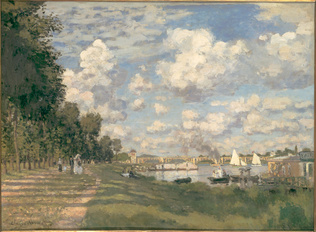
From December 1871 until 1878, Monet lived in Argenteuil. He would set up his easel out in the countryside or in his garden. But above all it was the Seine and the movement of the small boats which attracted the painter's attention. In his paintings, with their light and vivid colours, Monet shows his perfect mastery of the technique of fragmenting brush strokes, producing an interplay of luminous vibration. The left of the painting is taken up by the Argenteuil promenade, punctuated by the shadows of the trees planted along it. In the background there is a road bridge with a tollbooth at each end. On the right, in the foreground, there is the jetty of a bathing pool, then a washhouse. A major part of the painting is given over to clouds moving across the blue sky. As Daniel Wildenstein pointed out, Monet took several liberties with the motif. He only painted five arches on the bridge, which in reality had seven, and he raised the height of the tollbooths. The activity in Bassin d'Argenteuil recalls the beach scenes of Saint Adresse or those of the Grenouillère baths at Bougival before 1870. But here we have a particularly accomplished work, a brilliant starting point for a fruitful series, as Impressionism reached its peak during the Argenteuil period.


Object details
History - provenance, exhibitions, about this object record.
- collection Ernest Duez, Paris
- jusqu'en 1901, dans la collection Decap, Paris
- 1901, Vente Tableaux modernes... collection de M.X [Decap], Paris, Hôtel Drouot, 15 avril 1901, n°14
- de 1901 à 1911, dans la collection du comte Isaac de Camondo, Paris (acquis pour la somme de 16 500F à la Vente de Drouot du 15 avril)
- 1911, accepté par l'Etat à titre de legs du comte Isaac de Camondo pour le musée du Louvre (comité du 27/04/1911, conseil du 08/05/1911, arrêté du 23/11/1911)
- 1911, attribué au musée du Louvre, Paris
- de 1911 à 1947, au musée du Louvre, Paris (exposé à partir de 1914)
- de 1947 à 1986, au musée du Louvre, galerie du Jeu de Paume, Paris
- 1986, affecté au musée d'Orsay, Paris
- Deuxième exposition impressionniste - galerie Durand-Ruel - France, Paris, 1876
- Exposition du centenaire Monet-Rodin - musée de l'Orangerie - France, Paris, 1940
- Le paysage français de Poussin aux Impressionnistes - organisme inconnu - France, inconnu, 1956, ?, n°28 ?
- Loisirs sur l'eau - histoire de la plaisance en France 1640-1940 - palais de Chaillot - France, Paris, 1978, n°704
- Hommage à Claude Monet - Galeries nationales du Grand Palais - France, Paris, 1980
- Impressionnisme - fondation Anne et Albert Prouvost - France, Marcq-en-Baroeul, 1980-1981
- L'Impressionnisme et le paysage français - Los Angeles County Museum of Art - Etats-Unis, Los Angeles, 1984
- A Day in the Country: Impressionism and the French Landscape - The Art Institute of Chicago - Etats-Unis, Chicago, 1984-1985, n°44
- L'Impressionnisme et le paysage français - Galeries nationales du Grand Palais - France, Paris, 1985
- Budapest, 1869-1914 : modernité hongroise et peinture européenne - musée des Beaux-Arts - France, Dijon, 1995, n°174, p. 329
- Impressionists on the Seine. A celebration of Renoir's Luncheon of the Boating Party - The Phillips Collection - 1996-1997
- Impressionism: Paintings collected by European Museums - High Museum of Art - Etats-Unis, Atlanta, 1999, n°31
- Impressionism: Paintings collected by European Museums - Seattle Art Museum - Etats-Unis, Seattle, 1999, n°31
- Impressionism: Paintings collected by European Museums - Denver Art Museum - Etats-Unis, Denver, 1999, n°31
- The Impressionists at Argenteuil - National Gallery of Art - Etats-Unis, Washington, 2000, n°11, p. 69
- The Impressionists at Argenteuil - Wadsworth Atheneum Museum of Art - Etats-Unis, Hartford, 2000, n°11, p. 69
- Monet, i luoghi della pittura - Casa dei Carraresi - Italie, Trévise, 2001-2002
- Orte des Impressionismus Gemälde und Fotografien - Kunstmuseum Basel - Suisse, Bâle, 2003, n°19, p. 57
- Monet la Senna le ninfee. Il grande fiume e il nuovo secolo - Museo della città - Italie, Brescia, 2004-2005
- Temps d'harmonie : paradis d'artistes au XIXe siècle - City museum - Japon, Kobe, 2006
- Temps d'harmonie : paradis d'artistes au XIXe siècle - Metropolitan Art Museum - Japon, Tokyo, 2007
- De Millet à Bonnard. La création picturale dans les collections du musée d'Orsay (1848-1914) - Hangaram Art Museum - Corée, République de, Séoul, 2007
- L'impressionnisme au fil de la Seine - musée des Impressionnismes Giverny - France, Giverny, 2010
- Claude Monet 1840-1926 - Galeries nationales du Grand Palais - France, Paris, 2010-2011
- Impressionists on the Water - Legion of Honor - Etats-Unis, San Francisco, 2013
- Naissance de l'impressionnisme - National Art Center - Japon, Tokyo, 2014
- Monet. Un pont vers la modernité - musée des Beaux-Arts du Canada - Canada, Ottawa, 2015-2016
- Monet: The Early Years - Kimbell Art Museum - Etats-Unis, Fort Worth, 2016-2017
- Monet: The Early Years - Legion of Honor - Etats-Unis, San Francisco, 2017
- Impressionnisme : quelle modernité ? - Louvre Abu Dhabi - Emirats Arabes Unis, Abu Dhabi, 2022-2023
- Alexandre, Arsène, Les Arts , "Collection du comte Isaac de Camondo", Paris, [s.n.], 1908, p.32
- Anonyme, Catalogue de la collection Isaac de Camondo - Musée du Louvre , Paris, G. Braun, 1914, n°181, p. 35
- Jamot, Paul, La Collection Camondo au Musée du Louvre, les peintures et les dessins , Paris, La Gazette des Beaux-Arts, 1914, p.14, 42-44, ill. p.43
- Vitry, Paul ; Dreyfus, Carle ; Leprieur, Paul ; Migeon, Gaston, Catalogue de la collection Isaac de Camondo - Musée national du Louvre , Paris, Musées nationaux, 1922, n°181, p.39, non reprod.
- Brière, Gaston, Musée national du Louvre. Catalogue des peintures exposées dans les galeries. I. École française , Paris, Musées nationaux ; Palais du Louvre, 1924, n°CA. 181, p.189
- Regamey, Raymond, Gazette des beaux-arts , "Formation de Claude Monet", Paris, [s.n.], 1927, p. 82
- Léger, Charles, Claude Monet , Paris, G. Crès, 1930, n°7
- Reuterswärd, Oscar, Monet , Stockholm, A. Bonniers, 1948, p.282
- Bazin, Germain ; Adhémar, Hélène ; Sérullaz, Maurice, Catalogue des peintures, pastels, sculptures impressionnistes , Paris, Réunion des musées nationaux, 1958, n°248, p.131-132, non reprod.
- Anonyme, Catalogue des peintures du musée du Louvre , Paris, Réunion des musées nationaux, 1972, p. 272
- Adhémar, Hélène ; Dayez, Anne, Musée du Louvre, Musée du Jeu de Paume , Paris, Réunion des musées nationaux, 1973, p. 66, 151
- Adhémar, Hélène ; Dayez-Distel, Anne, Musée du Jeu de Paume - Catalogue rédigé , Paris, Editions des musées nationaux, 1977, p.157, reprod. p.68
- Bellony-Rewald, Alice, Le Monde retrouvé des impressionnistes , Paris, Seghers, 1977, p. 120-122
- Adhémar, Hélène [sous la direction de], Chronologie impressionniste : 1863-1905 , Paris, Réunion des musées nationaux, 1981, n°125
- Rossi Bortolatto, Luigina ; Bailly-Herzberg, Janine, Tout l'oeuvre peint de Monet. 1870-1899 , Paris, Flammarion, 1981, n°70, p.93, reprod. p.92 et pl.XXI
- House, John, Monet. Nature into art , New Haven, Yale University Press, 1986, n°143
- Patin, Sylvie, A la campagne , Paris, Réunion des musées nationaux, 1986, n°53
- Rosenblum, Robert, Les Peintures du Musée d'Orsay , Paris, Nathan, 1989, p. 276
- Tucker, Paul Hayes, Monet in the 90's. The seires paintings , Boston, The Museum of Fine Arts, 1989, fig. 4, p. 10
- Cachin, Françoise, Chefs-d'oeuvre du musée d'Orsay , New York, Artabras, 1994, n°80
- Shimada, Norio, La Seine des impressionnistes , Tokyo, Shogakukan, 1996, p. 97
- Cutting, James E., Impressionism and its canon , Lanham, University Press of America, 2006, p. 50
- Font-Réaulx, Dominique de, Turner i gli impressionisti : la grande storia del paesaggio moderno in Europa , 'Il paesaggio fotografato in Francia, 1845-1870" : [mostra, Brescia, 28 ottobre 2006-25 marzo 2007], Trévise, Linea d'ombra libri, 2006, p. 250
- Anonyme, Elger Esser, Eigenzeit , [Ausstellung, Stuttgart, Kunstmuseum, 28. November 2009 bis 11. April 2010, Arnhem, Museum voor moderne kunst, 11. Juli bis 26. September 2010], Munich, Schirmer ; Mosel, 2009, n°7, p.17, 148
- Ingres à Picasso : portraits et figures de femmes, cat. exp. (Paris, La Renaissance, 1928) , Paris, [s.n.], 1928
- Exposition du centenaire MONET-RODIN : au profit de l'entr'aide des artistes, cat. exp. (Paris, musée de l'Orangerie, 1940) , Paris, [s.n.], 1940, n° 9, p. 4 (non reprod.)
- Durand-Ruel, Charles, Impressionnisme, cat. exp. (Marcq-en-Baroeul, fondation Anne et Albert Prouvost, du 18/10/1980 au 25/01/1981) , Marcq-en-Baroeul, La Fondation, 1980, n° 18
- Brettell, Richard ; Gache-Patin, Sylvie ; Schaefer, Scott, L'Impressionnisme et le paysage français, cat.exp. (Los Angeles country museum of art, du 28/06/1984 au16/09/1984 ; Chicago, the Art institute of Chicago, du 23/10/1984 au 06/01/1985 ; Paris, Galeries nationales du Grand Palais, du 04/02/1985 au 22/04/1985) , Paris, Réunion des musées nationaux, 1985, n° 44
- Rathbone, Eliza E. ; Rothkopf, Katherine ; Brettell, Richard R., Impresionists on the Seine : a Celebration of Renoir’s Luncheon of the Baoating Party, cat. exp. (Washington, The Phillips Collection, 1996-1997) , Washington, Counterpoint, 1996, n° 17
- Goldin, Marco ; Murphy, Alexandra ; Stuckey, Charles F., Monet : i luoghi della pittura, cat. exp. (Trévise, Casa dei Carraresi, du 29/09/2001 au 10/02/2002) , Conegliano, Linea d'ombra Libri, 2001, n° 10, p. 88
- Goldin, Marco (dir.), Monet. La Senna. Le Ninfee. Il grande fiume e il nuovo secolo, cat. exp. (Brescia, Museo di Santa Giulia, 23 octobre 2004-20 mars 2005) , Conegliano, Linea d'ombra libri, 2004, n° 58
- Mathieu, Caroline ; Takahashi, Akiya ; Ono, Yoshiki, Collections du musée d'Orsay. Paradis d'artistes au XIXème siècle, cat.exp. (Kobé, Tokyo) , Tokyo, Nihon Keizai Shimbun, 2006, n° 21, p. 53
- Mathieu, Caroline ; Georgel, Chantal ; Lobstein, Dominique ; [et.al], De Millet à Bonnard : la création picturale dans les collections du Musée d'Orsay (1848-1914), cat.exp. (Séoul, 2007) , Paris, Musée d'Orsay, 2007, p. 40
- Patin, Sylvie ; Patry, Sylvie ; Roquebert, Anne ; Thomson, Richard, Monet, cat.exp. (Paris, Galeries nationales, Grand Palais, Paris, 22 septembre 2010-24 janvier 2011) , Paris, Réunion des musées nationaux ; Musée d'Orsay, 2010, n° 30, p. 131 (reprod.)
- Sterling, Charles ; Adhémar, Hélène, Musée du Louvre. Peintures... [Catalogue sommaire illustré] École française, XIXe siècle. vol. III , Paris, Réunion des musées nationaux, 1960, n°1371
- Wildenstein, Daniel, Claude Monet : catalogue raisonné Claude Monet. 1, 1840-1881, peintures , Paris, Bibliothèque des Arts ; Wildenstein institute, 1974, n°225
- Compin, Isabelle ; Roquebert, Anne, Catalogue sommaire illustré des peintures du Musée du Louvre et du Musée d'Orsay , Paris, Réunion des musées nationaux, 1986, vol.4, p.102
- Compin, Isabelle [coordination] ; Lacambre, Geneviève [coordination] ; Roquebert, Anne, Musée d'Orsay. Catalogue sommaire illustré des peintures , Paris, Réunion des musées nationaux, 1990, vol.2, p.329
Do you have a question where you have additional knowledge about this work? You can write to us to suggest improvements to the file.
Other artworks from artist
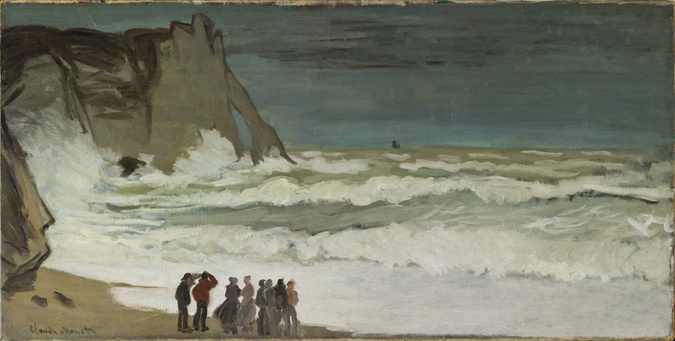
Claude Monet, Grosse mer à Etretat

Claude Monet, Le Pavé de Chailly

Claude Monet, Saule pleureur

Claude Monet, La Gare Saint-Lazare
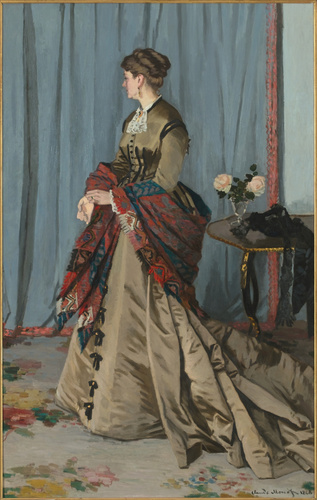
Claude Monet, Madame Louis Joachim Gaudibert
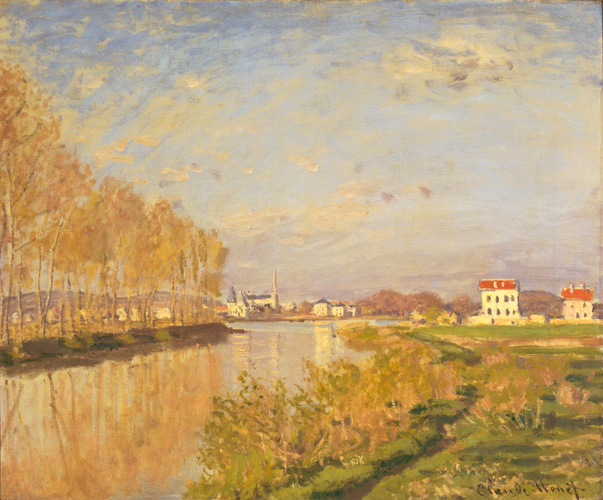
Claude Monet, La Seine à Argenteuil
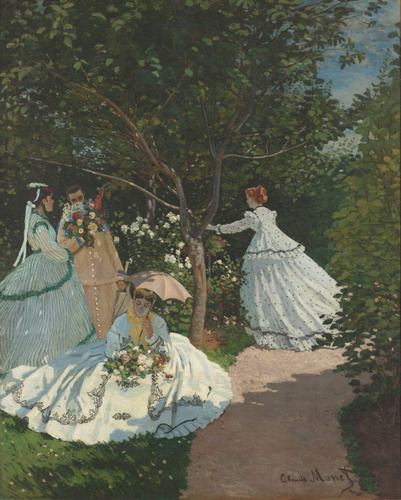
Claude Monet, Femmes au jardin
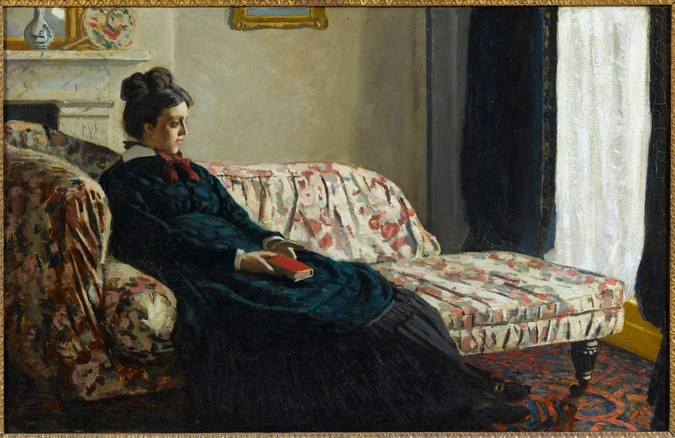
Claude Monet, Méditation. Madame Monet au canapé

Claude Monet
Description.
Claude Monet ( French , 1840-1926)
The Basin at Argenteuil (Le Bassin d'Argenteuil)
- Oil on canvas
Materials/Techniques
Signature / inscription / marks.
Signature: Signed LL:Claude Monet
Credit / Object Number
Gift of Mrs. Murray S. Danforth
Object Number
Purchased from the artist for 80 francs by Comte Jean de Rasty, possibly under the title Esquisse, Argenteuil; purchased from de Rasty by Alexandre Rosenberg for 3,500 francs, Paris, 1898; Lazare Weiller, Paris; Hotel Drouot, Paris, sale L. Weiller, November 29, 1901, no. 32; Bernheim-Jeune, Paris; Gaston Bernheim de Villiers, Paris, 1919; M. Knoedler, New York, 1928; Carroll Carstairs Gallery, New York, 1936; Mrs. Murray S. Danforth, Providence, 1938. Note: This provenance is published in Rosenfeld, RISD Museum, 1991.
Projects & Publications
Publications.

A Handbook of the Museum of Art, Rhode Island School of Design

European Paintings and Sculpture, ca. 1770 - 1937

Exchange Exhibition, Exhibition Exchange: From the Collection of Rose Art Museum, Brandeis University; From the Collection of The Museum of Art, Rhode Island School of Design, Providence.

Selected Works
Exhibition history.
The boat basin at Argenteuil, with its long promenade and terraced café, was a popular site for watching sailing regattas on the Seine. Monet set up his easel on an island across the river, distinguishing optical effects and textures with strategically varied brushmarks. Using pigments direct from tubes and mixed on his palette, he evoked the bramble of grasses in the foreground with congested jabs of color. Horizontal dashes capture the water and the reflections of broadly painted sailboats, and tiny dark and light flicks mark a procession of plane trees.
The boat basin at Argenteuil, with its long promenade and terraced café, was a popular site for watching sailing regattas on the Seine. Monet set up his easel on an island across the river, distinguishing optical effects and textures with strategically varied brushmarks. Using pigments direct from tubes and mixed on his palette, he evoked the bramble of grasses in the foreground with congested jabs of color. A dappled mosaic of horizontal dashes captures the movement of water and the reflections of broadly painted sailboats. Along the riverwalk, dark and light flicks of paint mark a procession of plane trees whose gray-green leaves and their purple shadows are rendered with a flattened touch.
Use & Feedback
The images on this website can enable discovery and collaboration and support new scholarship, and we encourage their use.
To request new photography, please send an email to [email protected] and include your name and the object's accession number.
We view our online collection as a living documents, and our records are frequently revised and enhanced. If you have additional information or have spotted an error, please send feedback to [email protected] .
Argenteuil Basin with a Single Sailboat is an oil on canvas autumn scene of the basin at Argenteuil , painted by French Impressionist artist Claude Monet in 1874. [1]
The piece was created during Monet's residence at Argenteuil, a town on the banks of the Seine , on the outskirts of Paris . Here Monet purchased a boat to be used as a floating studio and painted many scenes of the surrounding area. [1]
National Gallery of Ireland
The painting was purchased by Irish playwright and activist Edward Martyn in 1899, on the advice of his cousin, George Moore . It was bequeathed to the National Gallery of Ireland in 1924. [2] It is valued at €10m. [3]
Vandalism and restoration
At around 11am on 29 June 2012 a visitor to the gallery, Andrew Shannon, punched the painting causing "huge damage, shocking damage" [4] with "an extensive three-branched tear". [5]
After 18 months of restoration work, on 1 July 2014, the painting was re-hung in the gallery, behind protective glass. [3] The restoration saw 7% of the damaged area being lost, in a process that involved sewing microscopic threads back together. [4]
Shannon was jailed for 5 years for the attack. [6]
- "Argenteuil Basin with a Single Sailboat" . National Gallery of Ireland . Retrieved 18 January 2015 .
- "eMuseum" . National Gallery of Ireland. Archived from the original on 18 January 2015 . Retrieved 18 January 2015 .
- "Restored Monet returned to National Gallery" . RTÉ. 1 July 2014 . Retrieved 18 January 2015 .
- "Vandalised Monet work restored" . Belfast Telegraph. 1 July 2014 . Retrieved 18 January 2015 .
- "The Claude Monet Research & Conservation Project" . National Gallery of Ireland . Retrieved 18 January 2015 .
- Wheaton, Oliver (6 December 2014). "Man is jailed for punching a hole through an £8 million Monet painting" . Metro . Retrieved 18 January 2015 .
External links
- , National Gallery of Ireland information
- , National Gallery of Ireland restoration process
Where next?
Explore related content
Bassin d'Argenteuil
Claude monet circa 1872, musée d’orsay, paris paris, france.
From December 1871 until 1878, Monet lived in Argenteuil. He would set up his easel out in the countryside or in his garden. But above all it was the Seine and the movement of the small boats which attracted the painter's attention.
In his paintings, with their light and vivid colours, Monet shows his perfect mastery of the technique of fragmenting brush strokes, producing an interplay of luminous vibration.
The left of the painting is taken up by the Argenteuil promenade, punctuated by the shadows of the trees planted along it. In the background there is a road bridge with a tollbooth at each end. On the right, in the foreground, there is the jetty of a bathing pool, then a washhouse. A major part of the painting is given over to clouds moving across the blue sky.
As Daniel Wildenstein pointed out, Monet took several liberties with the motif. He only painted five arches on the bridge, which in reality had seven, and he raised the height of the tollbooths.The activity in Bassin d'Argenteuil recalls the beach scenes of Saint Adresse or those of the Grenouillère baths at Bougival before 1870. But here we have a particularly accomplished work, a brilliant starting point for a fruitful series, as Impressionism reached its peak during the Argenteuil period.
- Title: Bassin d'Argenteuil
- Creator Lifespan: 1840 - 1926
- Creator Nationality: French
- Creator Gender: Male
- Date Created: circa 1872
- Provenance: Bequest of Count Isaac de Camondo, 1911
- Physical Dimensions: w800 x h600 cm
- Painter: Claude Monet
- Original Title: Le Bassin d'Argenteuil
- Credit Line: © Musée d'Orsay, dist.RMN / Patrice Schmidt
- Type: Oil on canvas
- Rights: © Musée d'Orsay, dist.RMN / Patrice Schmidt
- External Link: https://www.musee-orsay.fr/en/collections
Get the app
Explore museums and play with Art Transfer, Pocket Galleries, Art Selfie, and more

Argenteuil Basin with a Single Sailboat
Argenteuil Basin with a Single Sailboat ( French : Bassin d'Argenteuil avec un seul voilier ) is an oil on canvas autumn scene of the basin at Argenteuil , painted by French Impressionist artist Claude Monet in 1874. [1]
National Gallery of Ireland
Vandalism and restoration, external links.
The piece was created during Monet's residence at Argenteuil, a town on the banks of the Seine , on the outskirts of Paris . Here Monet purchased a boat to be used as a floating studio and painted many scenes of the surrounding area. [1]
The painting was purchased by Irish playwright and activist Edward Martyn in 1899, on the advice of his cousin, George Moore . It was bequeathed to the National Gallery of Ireland in 1924. [2] It is valued at €10m. [3]
At around 11am on 29 June 2012 a visitor to the gallery, Andrew Shannon, punched the painting causing "huge damage, shocking damage" [4] with "an extensive three-branched tear". [5]
After 18 months of restoration work, on 1 July 2014, the painting was re-hung in the gallery, behind protective glass. [3] The restoration saw 7% of the damaged area being lost, in a process that involved sewing microscopic threads back together. [4]
Shannon was jailed for 5 years for the attack. [6]
- List of paintings by Claude Monet
Related Research Articles

Oscar-Claude Monet was a French painter and founder of impressionist painting who is seen as a key precursor to modernism, especially in his attempts to paint nature as he perceived it. During his long career, he was the most consistent and prolific practitioner of impressionism's philosophy of expressing one's perceptions of nature, especially as applied to plein air (outdoor) landscape painting. The term "Impressionism" is derived from the title of his painting Impression, soleil levant , exhibited in 1874 initiated by Monet and his associates as an alternative to the Salon.

Gustave Caillebotte was a French painter who was a member and patron of the Impressionists, although he painted in a more realistic manner than many others in the group. Caillebotte was known for his early interest in photography as an art form.

Alfred Sisley was an Impressionist landscape painter who was born and spent most of his life in France, but retained British citizenship. He was the most consistent of the Impressionists in his dedication to painting landscape en plein air . He deviated into figure painting only rarely and, unlike Renoir and Pissarro, he found that Impressionism fulfilled his artistic needs.
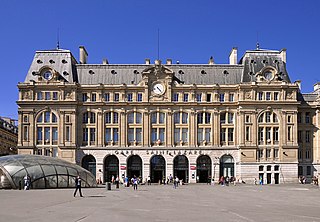
The Gare Saint-Lazare , officially Paris Saint Lazare , is one of the seven large mainline railway station terminals in Paris, France. It was the first train station built in Paris, opening in 1837. It mostly serves train services to western suburbs, as well as intercity services toward Normandy using the Paris–Le Havre railway. Saint-Lazare is the third busiest station in France, after the Gare du Nord and Gare de Lyon. It handles 290,000 passengers each day. The current station building opened in 1889 and was designed by architect Juste Lisch; the maître d'œuvre was Eugène Flachat.
Events from the year 1874 in art .
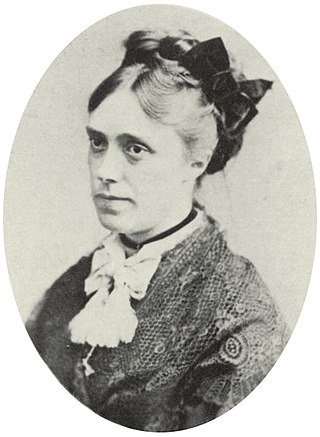
Camille-Léonie Doncieux was the first wife of French painter Claude Monet, with whom she had two sons. She was the subject of a number of paintings by Monet, as well as Pierre-Auguste Renoir and Édouard Manet.

The Thomas Crown Affair is a 1999 American romantic heist film directed by John McTiernan, written by Leslie Dixon and Kurt Wimmer and is a remake of the 1968 film of the same name. Its story follows Thomas Crown, a billionaire who steals a painting from an art gallery and is pursued by an insurance investigator with the two falling in love. It stars Pierce Brosnan, Rene Russo, and Denis Leary.

Saint-Georges majeur au crépuscule refers to an Impressionist painting by Claude Monet, which exists in more than one version. It forms part of a series of views of the monastery-island of San Giorgio Maggiore. This series is in turn part of a larger series of views of Venice which Monet began in 1908 during his only visit there.

A Girl with a Watering Can is an 1876 Impressionist oil painting on canvas by Pierre-Auguste Renoir. The work was apparently painted in Claude Monet's famous garden at Argenteuil, and may portray one of the girls in Renoir's neighborhood in a blue dress holding a watering can.

Snow at Argenteuil is an oil-on-canvas landscape painting by the Impressionist artist Claude Monet. It is the largest of no fewer than eighteen works Monet painted of his home commune of Argenteuil while it was under a blanket of snow during the winter of 1874–1875. This painting—number 352 in Wildenstein's catalogue of the works of Monet—is the largest of the eighteen. The attention to detail evident in the smaller paintings is less evident in this larger picture. Instead, Monet has rendered large areas of the canvas in closely like tones and colours of blue and grey. The application of smaller strokes of greens, yellows, reds and darker blues breaks up these large expanses, and the almost choreographed dispersal of these various colours helps bind the picture together. Paint at the depicted road surface is thicker than elsewhere in the painting, and impasto is suggestive of the feel of disturbed snow.
Argenteuil is a commune in the northwestern suburbs of Paris, France. It can also refer to:

Vandalism of art is intentional damage of an artwork. The object, usually exhibited in public, becomes damaged as a result of the act, and remains in place right after the act. This may distinguish it from art destruction and iconoclasm, where it may be wholly destroyed and removed, and art theft, or looting.

Bords de la Seine à Argenteuil is an oil painting by an unknown artist. The painting is a landscape depicting the River Seine at Argenteuil in France. It is owned by Englishman David Joel.

Springtime or The Reader is an 1872 painting by the French Impressionist painter Claude Monet. It depicts his first wife, Camille Doncieux, seated reading beneath a canopy of lilacs. The painting is presently held by the Walters Art Museum.
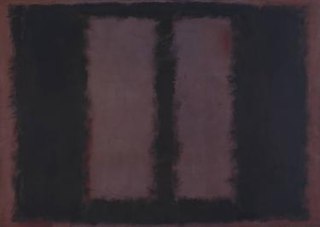
Black on Maroon is a mixed media painting by Mark Rothko, created in 1958. It is housed at the Tate Modern, in London.

The Fondation Claude Monet is a nonprofit organisation that runs and preserves the house and gardens of Claude Monet in Giverny, France, where Monet lived and painted for 43 years. Monet was inspired by his gardens, and spent years transforming them, planting thousands of flowers. He believed that it was important to surround himself with nature and paint outdoors. He created many paintings of his house and gardens, especially of water lilies in the pond, the Japanese bridge, and a weeping willow tree.

Woman with a Parasol – Madame Monet and Her Son , sometimes known as The Stroll is an oil-on-canvas painting by Claude Monet from 1875. The Impressionist work depicts his wife Camille Monet and their son Jean Monet in the period from 1871 to 1877 while they were living in Argenteuil, capturing a moment on a stroll on a windy summer's day.
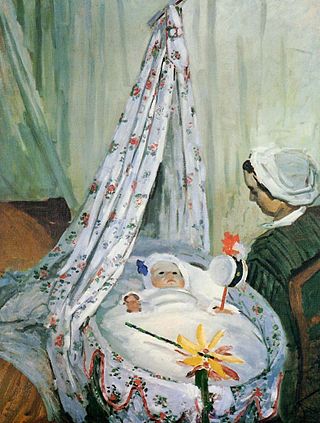
Jean Monet was the eldest son of French Impressionist artist Claude Monet and Camille Doncieux Monet and the brother of Michel Monet. He was the subject of several paintings by his father and married his step-sister, Blanche Hoschedé.

Michel Monet was the second son of Claude Monet and Camille Doncieux Monet.

The Train in the Snow , or Le train dans la neige , is a landscape painting by the French Impressionist artist Claude Monet. The work depicts a train surrounded by snow at the Argenteuil station in France. Art historians see the work as a significant example of Monet's efforts to integrate nature and industry in his work. Many historians believe that Monet, out of all of the notable nineteenth century artists, made the most paintings of trains in his lifetime.
- ↑ "eMuseum" . National Gallery of Ireland. Archived from the original on 18 January 2015 . Retrieved 18 January 2015 .
- 1 2 "Restored Monet returned to National Gallery" . RTÉ . 1 July 2014 . Retrieved 18 January 2015 .
- 1 2 "Vandalised Monet work restored" . Belfast Telegraph . 1 July 2014 . Retrieved 18 January 2015 .
- ↑ "The Claude Monet Research & Conservation Project" . National Gallery of Ireland . Retrieved 18 January 2015 .
- ↑ Wheaton, Oliver (6 December 2014). "Man is jailed for punching a hole through an £8 million Monet painting" . Metro . Retrieved 18 January 2015 .
- , National Gallery of Ireland information
- , National Gallery of Ireland restoration process
File : Monet-ArgenteuilBasinWithASingleSailboat.jpg
File history, file usage on commons, file usage on other wikis.

Original file (3,000 × 2,501 pixels, file size: 1.55 MB, MIME type: image/jpeg )
Summary [ edit ]
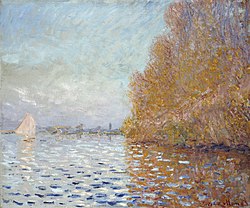
Click on a date/time to view the file as it appeared at that time.
You cannot overwrite this file.
The following 5 pages use this file:
- Claude Monet catalogue raisonné, 1996 Wildenstein
- Paintings by Claude Monet
- File:Claude monet, bacino di argenteuil con un'imbarcazione a vela, 1874.jpg
- File:Monet-ArgenteuilBasinWithASingleSailboat.jpg
- Category talk:Paintings by Claude Monet
The following other wikis use this file:
- National Gallery of Ireland
- Κατάλογος έργων του Κλωντ Μονέ
- User:LookingYourBest
- List of paintings by Claude Monet
Structured data
Items portrayed in this file, digital representation of, main subject.
- Paintings of the Seine in Argenteuil by Claude Monet
- 1870s paintings by Claude Monet
- 1874 oil on canvas paintings
- Bassin d'Argenteuil
- Pages with complex technique templates
- PD-old-95-expired
- Artworks with Wikidata item
- Artworks with accession number from Wikidata
- Artworks with known accession number
- Artworks with Wikidata item missing genre
- Artworks digital representation of 2D work
Navigation menu
Restored Monet painting worth €10m unveiled at National Gallery
Man allegedly put his hand through argenteuil basin with a single sailboat in 2012.
A €10 million Claude Monet painting, which was damaged in 2012 when a man allegedly put his hand through it, is back on display at the National Gallery in Dublin after 18 months of extensive conservation work.
A Claude Monet painting, which was damaged when a man allegedly put his hand through it has gone back on display in the National Gallery after extensive repair work.
Argenteuil Basin with a Single Sailboat was unveiled today after 18 months in the gallery's restoration department.
A man is currently before the courts charged with criminally damaging the work in June 2012.
The painting, which is the only one from the French impressionist in the National Gallery, dates from 1874 and is valued at €10 million.
The damage involved an extensive three branch tear. Fragments of paint and priming layers had also been lost from the surrounding site of the damage.
National Gallery director Sean Rainbird said the conservation team had done a "phenomenal job".
“This project to restore and conserve one of the gallery’s most popular Impressionist works of art is testament to the outstanding expertise and dedication of our professional team of conservators,” he said.
The project was undertaken with support from French bank BNP Paribas and cost a “five figure” sum, Mr Rainbird added.
He went on to say that although the incident in which the painting had been damaged was “traumatic” the gallery does have good security systems in place. Mr Rainbird said there is an inherent contradiction in putting priceless items on public display.
“You could say lock ‘em all up but that’s not what we’re here for,” he said.
The painting, which is now behind a protective sheet of glass, is once again hanging in its old spot in the gallery’s Millenium Wing. The repair work is subtly visible, which, the conservationists say, is in keeping with current ethics around the restoration of museum pieces.
Argenteuil Basin with a Single Sailboat was bequeathed to the Gallery by the Irish dramatist and politician Edward Martyn (1859- 1923).
Martyn is thought to have acquired the painting on the advice of his cousin, the writer George Moore (1852-1933), who had lived in Paris and was well acquainted with Impressionist artists.
Dan Griffin
Dan Griffin is an Irish Times journalist
IN THIS SECTION
Girls aloud review: the last great manufactured pop band make a triumphant return that is tinged with sadness, george stephanopoulos: ‘you can only have constructive debates if people are determined to engage in good faith’, colm tóibín: ‘writing a sequel to brooklyn the risk is cheapness’, charlie bird’s wife claire on his last story: ‘i will try to live my life without this great man beside me’, ten minutes with jennifer lopez: ‘how do i go where my heart is leading me without fear i say tread forward’, big parties set to win seats in each of three european parliament constituencies, poll finds, cyclist (70s) dies following road crash involving car on dame street in dublin, irish workers among the least productive in europe, study indicates, how ireland drinks now: teetotallers, wine-o’clockers and ex-drinkers, every time i travel abroad i am gripped by the fear that ireland is making a fool of me, latest stories, scottie scheffler willing to go to trial over assault charge, says lawyer, thousands march in dublin calling for end to violence in gaza, kerry head and shoulders above rusty monaghan in one-sided killarney opener, kerry see off cork to secure first munster senior ladies title since 2017, georgia’s president salome zourabichvili vetoes controversial ‘foreign agents’ bill.
:quality(70)/cloudfront-eu-central-1.images.arcpublishing.com/irishtimes/SJQTLMCMMRC2PLALXUKEWWS6HU.png)
- Terms & Conditions
- Privacy Policy
- Cookie Information
- Cookie Settings
- Community Standards

In Focus: the flâneur

In our ongoing adult learning series, we link works from our collection with key art historical, theoretical or philosophical texts. Aimed especially at third-level students, but accessible to all, this series aims to support in-depth engagement with our collection and the selected texts.
In this post , we consider Claude Monet’s fishing boat, which he used as a floating studio, in the context of the flâneur, a wandering observer of urban spaces.
Key artwork
Claude Monet (1840-1926), Argenteuil Basin with a Single Sailboat, 1874
Walter Benjamin, The Arcades Project, M The Flâneur , p.416-455 [via Monkskop]
In this discussion we will link the concept of the flâneur (one who strolls the streets with a keen observational eye) with Claude Monet’s experience of drifting through the Argenteuil Basin on the boat that he used as his ‘floating studio’. Although we will be considering Monet in a context other than that of one of the key figures of the French Impressionist movement, this post will nonetheless help us to understand elements of Impressionism.
Impressionist painting, most often practiced as plein air painting (painting outdoors), prioritises the articulation of perceptions of light. Monet was committed to capturing his impressions of nature in the French countryside; he exemplified this commitment by painting the same scene again and again, in an effort to harness specific light from a time in the day, a method which was also useful in recording shifts in the seasons.
Monet purchased an old fishing boat in Argenteuil on the outskirts of Paris, where he moved in 1871. He describes the acquisition of this boat, saying “a fair wind had brought me just enough money in one go to buy a boat and have a wooden cabin built on it just big enough to set up an easel”.
For this discussion, a key thing to consider is that Monet’s floating studio allowed him to paint views that would otherwise have been inaccessible. Through its use, Monet created a space in which he could access scenes of the Argenteuil and Giverny, allowing him to observe and document from a distance. We can make connections between this way of painting and the gaze of the flâneur.
Monet relished understanding how optical effects influenced his perception of the world. Impressionism helps us to understand colour as light, and colour as pigment. Colour theory draws on the colour spectrum, which is made up of light. In painting, particularly Impressionism, we experience colour as solid stuff (synthetic or solid pigments) that depicts colour as light. The way Monet recorded light was by focusing attention on a particular iteration of light in a space, all the while knowing that the same space would transform into multiple other versions as a result of the changing properties of a day or a season. To capture something as fleeting as light on a particular day, or in a particular instant, an artist needs to possess a sense of immediacy both in perception, and in the application of paint. If we imagine the gaze of the Impressionist painter, it chases what is fleeting and renders its appearance into paint on the surface. Monet’s floating studio and his method of repeatedly painting the same scene finds parallels in the flâneur.
The flâneur, who has his origins in 19 th century France, is an individual, male in this context (more recently, a female equivalent has been defined as a flâneuse, explored in detail by the writer Lauren Elkin in her book of the same name ) who strolls through city streets closely observing all its accompanying associations. The flâneur has the ability and the time to wander society while also being removed from it. His purpose is to observe society and only that: he therefore appears aimless.
While Monet observed light, most often in natural settings, the urban setting of Paris was where the flâneur experienced a phantasmagoria, captivated by sequences of images, creating clashes of meaning from that which he observed in the city. Can we compare Monet’s floating studio, drifting through Argenteuil, with the flâneur roaming Parisian streets? Can the movement of light on water share the vitality of a bustling market? Does a specific light shimmering on branches and leaves echo the endlessly stimulating details of a busy city arcade? The flâneur, a poet in the streets, sees the world through a kaleidoscope, finds solitude in a crowd, and delights in anonymity. He treats everyday life as its own creative space. He thrives in the demands of immediacy, observing the fleeting in the moment in which they occur.
The flâneur has been used to explain modern alienation, and gender and class divisions in Western cities of the 19th century. The French poet Charles Baudelaire ( 1821-1867) saw a need for artists to immerse themselves in the new social and economic realities that were brought on by industrialisation. In his view, traditional art did not have a place in this newly complex modern world. For Baudelaire, the artist needed to become “a botanist of the sidewalk”. This was considered an essential role that the metropolis demanded; a role that was responsible for understanding and portraying a city.
The crowd is his element, as the air is that of birds and water of fishes. His passion and his profession are to become one flesh with the crowd. For the perfect flâneur, for the passionate spectator, it is an immense joy to set up house in the heart of the multitude, amid the ebb and flow of movement, in the midst of the fugitive and the infinite. (Charles Baudelaire, The Painter of Modern Life, (Le Figaro), 1863)
The flâneur is a key motif in The Arcades Project, a major work by t he 20th century philosopher and critical theorist, Walter Benjamin (1892-1940). A n unfinished work written between 1927 and 1940, The Arcades Project was a monumental collection of writings on the city life of Paris in the 19th century. It focused on the glass and iron covered arcades which predated department stores and were a prominent feature of 19 th century Western cities. Paris had exceptional examples of these glass-roofed corridors lined with shops, brimming with desirable goods.
After Benjamin’s death, The Arcades Project was left unfinished in multiple parts. Its form was highly innovative in its time, and it is considered by many to be one of the most significant critical theory works of the 20 th century. It is presented as a montage of extracts by 19th century writers and contemporaries of Benjamin’s, with intermittent commentary from Benjamin himself. Readers are invited to combine textual fragments and experience comparative thinking. A version of this unfinished text was posthumously edited in 1982, and the flâneur is situated from a Marxist standpoint: a bourgeois dilettante, and a product of modern life.
Benjamin’s text takes the flâneur in multiple directions, presenting the reader with the potential for imaginative flashes of thought by connecting sections on the flâneur with other elements of the text. The gaze of Monet in his floating studio, the kaleidoscopic nature of the flâneur’s gaze and indeed Benjamin’s fragmented approach to this project, can all be considered in the context of one another. Benjamin offers ideas on the flâneur using language that signifies the experience of the painter, describing the flâneur’s strolling as an accumulation of “momentum”, and the city as a “landscape” that “feeds…sensory data”.
He also includes a quote from physician Jean François Dancel that captures a static stance of the sailor:
"When one is sailing on a river or lake, one's body is without active movement . . . .The skin experiences no contraction, and its pores remain wide open and capable of absorbing all the emanations and vapors of the surrounding environment…" (Dancel, 1846)
This is an idea that we can twist for the purposes of this discussion: while in his floating studio, Monet’s body was almost fully stationary, his motion dependent on the mechanisms of the boat. There is, however, another element of motion at play - the act of looking and painting. This eye movement or fixation on a brief veil of light can be understood as an exception to this image of the stationary sailor, bringing Monet in his floating studio closer still to the wandering, mobile flâneur.
When we look at the painting Argenteuil Basin with a Single Sailboat, we can see that it embodies one of the key motifs of Impressionism, with short, thin brushstrokes. Here, we don’t see crowds: we see water, trees and a single sailboat. The silence of Monet’s observation echoes the subtle footsteps of the flâneur. Monet found subjects for his painting from his immediate environment, which he perceived from a somewhat removed and objective eye. His determination to observe scenes of the River Seine from his floating studio brings Monet conceptually closer to observers of the modern metropolis nearby.
- How can we compare observations of natural spaces e.g. a river versus constructed spaces like a department store?
- Can we understand constructed spaces like cities as a part of nature?
- What are the sociopolitical implications of the existence of the flâneur in 19 th century cities?
- In your view, can a version of the flâneur exist in digital space?
Further reading:
- Baudelaire, Charles, The Painter of Modern Life Translated by Jonathan Maine (1964) London, Phaidon Press.
- Sontag, Susan, (1977) On Photography, USA & Canada, Penguin Books.
Written by: Jennie Taylor, National Gallery of Ireland
Related content:

In Focus: the sublime in art
Linking the collection with art historical, theoretical or philos

In Focus: Cubism
Connecting the collection to art historical, theoretical or philo

In Focus: The Emancipated Spectator

Moment in Time: Reading the exhibition
A reading list of American literature and poetry.

Argenteuil Basin with a Single Sailboat (Q19570879)
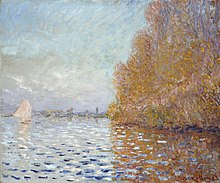
Wikibooks (0 entries)
Wikinews (0 entries), wikiquote (0 entries), wikisource (0 entries), wikiversity (0 entries), wikivoyage (0 entries), wiktionary (0 entries), multilingual sites (0 entries).
Navigation menu
- The Inventory
How a $12 Million Monet Was Repaired After Some Idiot Punched It
Almost three years ago, an unhinged Irish gentleman named Andrew Shannon punched a 141-year-old Monet painting hanging in Ireland's National Gallery. Argenteuil Basin with a Single Sailboat was ruined—or so it seemed.
The painting had three jagged rips down its center, twisted outward from where Shannon's fist hit the canvas. Shannon, for his part, is now serving a five-year sentence for his crime, which Metro UK explained as "an attempt to 'get back at the state.'" But the painstaking restoration has taken almost as long as his prison sentence.
Related Content
While it seems beyond repair in the image above, conservators at the National Gallery posted a detailed account of what sounds a lot like a harrowing surgery on its website.
First, they made sure that they had all the pieces. This is a 130-year-old painting, and when it was punched, says the gallery, "tiny fragments of paint and ground came loose and were deposited on the painting's surface or on the ground nearby." They had to carefully pick up and classify all these crumbs and flakes of paint so they could be restored.
Even then, some of the pieces are too small to figure out where they belong. "Seven percent of the fragments lost during the damage were so tiny that even with a powerful microscope, it was impossible to relocate them back into the painting," says the gallery. They still played a useful role in the restoration though; the lab was able to chemically analyze them to figure out the makeup of the paint Monet used.
Knowing more about the provenance of the paint, it was time to get started. Repairing the painting would require it to be turned upside down—it was placed on a "padded cushion"—and to "stabilize" it, the team covered the painted side with "a low-concentration of water-based, animal glue." The idea was to make the paint itself stronger while so much was happening on the other side of the canvas.
Then came the real work:
With the aid of a high-powered microscope and appropriately small tools, the tear edges were carefully aligned thread-by-thread. Re-joining of the realigned, broken canvas fibres involved applying a specially formulated adhesive to achieve a strong but reversible bond between the thread ends. This adhesive material has been used and developed by painting conservators in Germany over the past 40 years. Examples shown here include small steel surgical tools for working on tiny areas using a microscope; mini hot spatula for applying controlled and localised heat to the painting; warming plate and glass containers for keeping adhesive at a consistent temperature. Hydrated collagen adhesive was made in-studio.
If it sounds like surgery, that's because it is. The aging, fragile threads are almost like blood vessels that need to be carefully and gently tied off or rejoined. Any mistakes, and the entire painting could have been lost.
But there was still a huge scar down the middle of the painting. So, like piecing together a puzzle, the team placed those collection paint fragments back where they belonged using a microscope—and then used gesso and watercolor to retouch the remaining lines.
One of the most interesting things about the detailed account of the restoration is that along the way, every single technique was designed to be reversible . This is an idea that runs throughout art restoration and even archaeology, that, even though we might think we're improving or studying a piece of history in the least harmful way possible, it's likely that the conservators of the future will have better technology and better techniques for the work we're doing now.
So they make sure to leave clear and careful breadcrumbs. Clues that, decades from now, might help future conservators understand how better to make this battered, beautiful painting whole. [ National Gallery ; h/t Hyperallergic ]
All images via the National Gallery of Ireland .
Monet Collection " Argenteuil Basin With A Single Sailboat " by Claude Monet on Canvas
See More by Vault W Artwork
Rated 0 out of 5 stars.
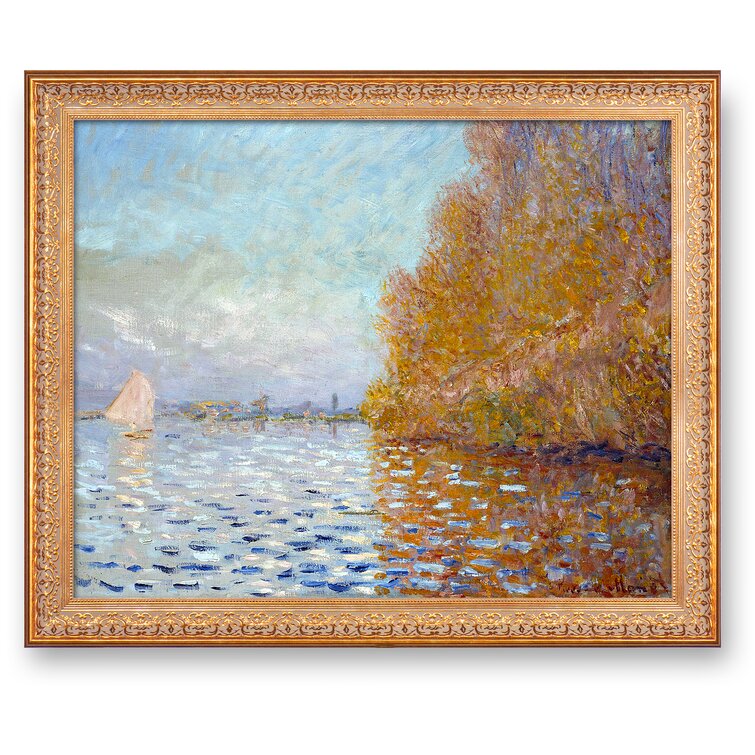
1. Select Format:
Golden Framed
2. Select Size:
Not Selected
24.5"H x 20.5"W x 0.75"D
Product Overview

Oil Painting

Artist: Claude Monet
Description
- All Framed Arts are 100% Made in the USA
- Hight Quality (ILG)Vintage Pattern Gold Framed Art,Framed Size:24 1/2 x 20 1/2" Image Size:20x16"
- Our Framed Art work made with Better quality Certified green-100% Frames. frames& Solvent-free Ink: Epson professional photo printer and original UltraChrome HD pigment ink which is certified eco-friendly and odorless can produce more details for your artwork and lasting longer.
- For giclee printing, the canvas used to actually print the final piece must be of archival quality. it is acid free and consists of cotton base. Museum-quality pieces printed,
- Ready to Hang
Weights & Dimensions

Other Dimensions
Specifications, more about this product, ratings & reviews.
Our Community Guidelines help customers write honest reviews.
Unfortunately, this product has no reviews.
Shipping & Returns
Your order means a lot to us. That’s why we offer fast, safe and reliable delivery options for every item.
30-Day Return
Not loving it? We offer returns for most items within 30 days of delivery for a refund or store credit.
Customers Also Viewed
" impression sunrise " painting print on canvas.
by Astoria Grand
Rated 3 out of 5 stars. 3 total votes
Impression Sunrise - Painting Print on Canvas is a premium hand-wrapped giclee canvas. Each frame is custom cut and mounted by hand and applied with a custom printed hand wrapped giclee printed canvas.
'The Rest on the Flight Into Egypt with St. John the Baptist' Print on Canvas
by East Urban Home
- Professionally hand stretched
- Ready to hang
- Museum quality giclee on canvas
- Gallery wrapped with image mirrored onto the sides
Chapelton at Argenteuil' by Claude Monet - 3 Piece Wrapped Canvas Painting
by Highland Dunes
This multi-piece image is such a versatile decorative accent. It layers your personal style into your home, fills in the blanks on an empty wall, and brings a wall to life. Ready to hang, you need only to apply an anchor to the wall of your choice.
- Printed and inspected one at a time utilizing the latest archival UltraChrome giclée inks
" Late Afternoon In Vetheuil " by Claude Monet on Canvas
by Vault W Artwork
Rated 4 out of 5 stars. 20 total votes
Featuring a high quality reproduction of an original masterpiece
- Gallery wrapped premium canvas
'Virgin of The Fish' Print on Canvas
Museum quality giclee on canvas. Hand stretched on deep gallery wrapped with image mirrored onto the sides.
- Professionally hand stretched on 1.5" stretcher bars
- Artist-grade canvas using archival inks
- Hand crafted in the USA
" The Beach At Trouville " by Claude Monet on Canvas
by DECORARTS
This personalized canvas is a great art piece for your wall decor. Our Giclee Print Technology uses archival-quality inks onto premium canvases, and guarantees incredible detail, phenomenal quality, and vibrant colors. We also use Semi-Gloss Acrylic Coating applied to waterproof for surface, enhance the texture of the painting to make better version and touch. Thus extending the lifetime of the print and keeping it from fading. All our products are made in the USA.
- "Beach at Trouville" Reproduction: Monet's coastal masterpiece, artfully recreated for timeless elegance.
- Giclee print on acid-free cotton canvas for vibrant, lasting colors, and wall art longevity.
- Gallery wrap, ready to hang, includes free professional picture hanging tools.
'Road Of La Rocheguyon' Print on Wrapped Canvas
Rated 5 out of 5 stars. 1 total vote
- This ready to hang and gallery-wrapped art piece features a landscape showing a city in the distance of the frame
- Made in the USA
Blue Duo - Wrapped Canvas Painting Print
by Winston Porter
Rated 4 out of 5 stars. 51 total votes
Ready to hang. A premium hand-stretched gallery canvas print was created to last. Featuring a beveled wood stretcher bar, each piece comes ready to hand. Built to last. Each piece comes ready to hang. Fade and water-resistant. Made domestically.
" L'Estaque " by Pierre-Auguste Renoir on Canvas
Rated 5 out of 5 stars. 3 total votes
The hand-painted oil reproduction of a famous Renoir painting L'Estaque. Originally created in 1882 today it has been carefully recreated detail-by-detail, color-by-color to near perfection. In the 1870s Renoir's Impressionist technique reached its peak, with glorious accomplishment. His fully defined technique rendered facial expressions and movements masterfully. He spent weeks and sometimes months perfecting his paintings. Why not grace your home with this reproduced masterpiece? It is sure to bring many admirers! Frame description: Burgeon Gold frame - Organic Pattern Facade with Gold finish.
- Framed paintings arrive ready to hang on your wall with hanging hardware included
- Certificate of authenticity included
The Water Garden by Claude Monet - Print on Canvas
by The Twillery Co.®
Rated 4 out of 5 stars. 280 total votes
Bring home the beauty of Claude Monet's "The Water Garden" with this premium giclee canvas print. This piece showcases the tranquil allure of Monet's famous water lilies in shades of green, blue, and white. The landscape-oriented print is stretched over a solid wood stretcher and gallery wrapped to create a seamless look that's ready to hang. It comes complete with wall mounting hardware, so you can effortlessly display this classic work of art in your living room or bedroom.
- Solid wood stretcher
- Giclee printed
Thanks for reading Hyperallergic!
Enter your email below to subscribe to our free newsletters.
Newsletters
- Daily The latest stories every weekday morning
- Weekly Editors' picks of the best stories each week
- Opportunities Monthly list of opportunities for artists, and art workers
View all newsletters | Privacy Policy
An account has already been registered with this email. Please check your inbox for an authentication link to sign in.
Hyperallergic
Sensitive to Art & its Discontents
How to Fix a Monet After Somebody Punches It
Support Independent Arts Journalism
As an independent publication, we rely on readers like you to fund our journalism and keep our reporting and criticism free and accessible to all. If you value our coverage and want to support more of it, consider becoming a member today.

Claude Monet, “Argenteuil Basin with a Single Sailboat” (all images courtesy of National Gallery of Ireland)
Conservators are probably the closest thing the art world has to surgeons. With care and precision, they repair wounds caused by old age, negligence, and, every once in a while, crazed attackers — as happened in 2012 to Claude Monet’s “Argenteuil Basin with a Single Sailboat.” Painted in 1874, it was punched by an angry madman as it hung in Ireland’s National Gallery.
The team tasked with repairing the artwork had their work cut out for them. The assailant had left a massive triangular tear in the middle of the canvas, and some of the paint had been so badly pulverized that it couldn’t be reattached. Over the course of two years, conservators worked carefully to repair the painting and restore it to its original condition. A true labor of love, the project was recently documented on the museum website and has been reproduced here with its permission. Take a look.

After the painting was removed from the wall, conservators laid the painting flat to remove it from its frame.

Conservators then tested the paints and varnish Monet used to figure out which modern materials would be the most compatible with their 19th-century counterparts.

The conservators had to spend a good deal of time researching Monet’s painting technique and how other institutions had approached similar projects before embarking on the restoration itself.

The major repairs were made to the back of the painting. Before turning it over, conservators applied a temporary tissue cover to protect its surface. They used a special water-soluble glue that temporarily makes the painting stronger and is easily removed. Once this was done, the tacks were painstakingly removed from the stretcher.

The tears in the canvas had sharp, jagged edges which had to be flattened, aligned and rejoined together with the help of a powerful microscope and tiny tools. Conservators bound them together with an adhesive first developed in Germany more than 40 years ago.

These are a few of the conservators’ tools and materials: a mini hot spatula for applying heat, a warming plate, and glass containers for holding glue.

After the tear was repaired, the canvas was turned upright and its protective tissue removed. The surface was cleaned, lightening the canvas and bringing it closer to how it originally looked.

Because the painting had been so badly damaged, conservators had to add a secondary canvas to support the original.

Once this was completed, the canvas was returned to the stretcher and tacked on with as many original tacks as possible.

Next, conservators reinserted what fragments of paint they could, though many had been pulverized into a fine dust that was impossible to reapply.

In the holes that remained, conservators inserted a reversible, pigmented gesso made from chalk and a tiny amount of animal gelatin glue. Finally, they retouched the painting with watercolor.
- Share Copied to clipboard
Laura C. Mallonee
Laura C. Mallonee is a Brooklyn-based writer. She holds an M.A. in Cultural Reporting and Criticism from NYU and a B.F.A. in painting from Missouri State University. She enjoys exploring new cities and... More by Laura C. Mallonee
6 replies on “How to Fix a Monet After Somebody Punches It”
I think you mean Conservationists, not “Conversationists.”
Actually (misspelling aside), it’s the term that is wrong. Conservationists are into wildlife. Conservators take care of objects. I’m a museum conservator (plural, conservators, never ever ever conservationist or conservationists) so you can take my word for it. A nice article though! 🙂
We corrected the mistake soon after it was published. Why are these comments coming now? Are you seeing an old version?
digg is to blame
It was indeed a good article and thanks for the distinction Ally! I sent this to a friend who is a newly trained conservator and she mentioned that the photos were very important. Thanks again.
the link to the article still says “conversationists”. Love the article!
Comments are closed.
Most Popular
Spray-painting “me too” on a courbet is not the feminism we need.
- Portrait of King Charles Gives New Meaning to “Bloody Hell”
- Leonora Carrington Masterpiece Sells for $28.5M, Shattering Records
- How the Met Gala Catalyzed a “Celebrity Block Party”
- Six New York Shows to Close Out Your May

Hundreds Attend Historic “Counter-Commencement” for Columbia Students at NYC Cathedral
The ceremony was organized by members of the university faculty in a repudiation of leadership’s decision to send police to arrest pro-Palestine demonstrators.

Striking Parsons Students Withdraw Artwork From Thesis Exhibition
A dozen students are staging an alternative BFA show in Brooklyn amid Students for Justice in Palestine’s ongoing strike against the New School.

Enhance Your Practice With SVA Continuing Education Courses, Workshops, Residencies
The School of Visual Arts Continuing Education in NYC offers a diverse range of more than 200 online and on-campus courses and over 10 artist residency programs.

School of Visual Arts Students Hold Moment of Silence for Gaza Children
At an exhibition opening in the school’s Flatiron gallery, students read the names of young Palestinians killed by Israeli attacks.

Top Art Patrons Discussed Deploying NYPD Against Columbia Students
Private chats obtained by the Washington Post show how art-world stakeholders sought to influence Mayor Eric Adams and Columbia leadership.

OXH Gallery Debuts Exhibition Exploring Motherhood
Women artists from around the world delve into the complexities of maternity and the body in this new show in Tampa, Florida.

Deborah De Robertis’s protest performance signifies precisely what is wrong with current feminist discourse.

Required Reading
This week, remembering writer Alice Munro, double standards for student protesters, the cinematic history of cigarettes, BBC ’s iconic jingle, and more.

Vilcek Foundation to Award $300,000 in Prizes to Immigrant Artists and Curators
Immigrant arts professionals are encouraged to apply for a 2025 Vilcek Prize for Creative Promise by June 10.

Man Ray’s Beguiling and Bemusing Filmscapes
Man Ray’s Return to Reason film series anticipated the extent to which the motion picture would inform how we curate and call up memory.

The Monstrous Femininity of Maureen St. Vincent
The artist’s aquatic pastels represent women who cannot be domesticated or controlled.
We've recently sent you an authentication link. Please, check your inbox!
Sign in with a password below, or sign in using your email .
Get a code sent to your email to sign in, or sign in using a password .
Enter the code you received via email to sign in, or sign in using a password .
Subscribe to our newsletters:
- Podcast Updates on the latest episodes
- Store Updates & special offers from our store
- Film Film reviews and recommendations
- Books Book reviews and recommendations
- Los Angeles Weekly guide to exhibitions in LA
- New York Weekly guide to exhibitions in NYC
Sign in with your email
Lost your password?
Try a different email
Send another code
Sign in with a password
Privacy Policy
Argenteuil Basin with a Single Sailboat
Argenteuil Basin with a Single Sailboat is an oil on canvas autumn scene of the basin at Argenteuil , painted by French Impressionist artist Claude Monet in 1874. [1]
- 2.1 Vandalism and restoration
- 3 References
- 4 External links
The piece was created during Monet's residence at Argenteuil, a town on the banks of the Seine , on the outskirts of Paris . Here Monet purchased a boat to be used as a floating studio and painted many scenes of the surrounding area. [1]
National Gallery of Ireland
The painting was purchased by Irish playwright and activist Edward Martyn in 1899, on the advice of his cousin, George Moore . It was bequeathed to the National Gallery of Ireland in 1924. [2] It is valued at €10m. [3]
Vandalism and restoration
At around 11am on 29 June 2012 a visitor to the gallery, Andrew Shannon, punched the painting causing "huge damage, shocking damage" [4] with "an extensive three-branched tear". [5]
After 18 months of restoration work, on 1 July 2014, the painting was re-hung in the gallery, behind protective glass. [3] The restoration saw 7% of the damaged area being lost, in a process that involved sewing microscopic threads back together. [4]
Shannon was jailed for 5 years for the attack. [6]
- ↑ 1.0 1.1 Lua error in package.lua at line 80: module 'strict' not found.
- ↑ Lua error in package.lua at line 80: module 'strict' not found.
- ↑ 3.0 3.1 Lua error in package.lua at line 80: module 'strict' not found.
- ↑ 4.0 4.1 Lua error in package.lua at line 80: module 'strict' not found.
External links
- [1] , National Gallery of Ireland information
- [2] , National Gallery of Ireland restoration process
<templatestyles src="Asbox/styles.css"></templatestyles>
- Pages with broken file links
- 1874 paintings
- Paintings by Claude Monet
- 19th-century painting stubs
- Pages with script errors
- All stub articles
Navigation menu
Personal tools.
- Request account
- View source
- View history
- Recent changes
- Random page
- Infogalactic News
- Buy an account
- What links here
- Related changes
- Special pages
- Printable version
- Permanent link
- Page information
- Cite this page
- This page was last modified on 8 March 2016, at 23:05.
- Content is available under Creative Commons Attribution-ShareAlike License unless otherwise noted.
- This article's content derived from Wikipedia, the Free Encyclopedia ( See original source ).
- Privacy policy
- About Infogalactic: the planetary knowledge core
- Disclaimers
- Mobile view

IMAGES
COMMENTS
Argenteuil Basin with a Single Sailboat by Claude Monet (1840-1926) From 1871 to 1878, Monet lived in Argenteuil on the outskirts of Paris. During this period, he fitted out a boat as a floating studio and painted many views of the River Seine and its banks. He made this picture in 1874, the year that the first Impressionist exhibition was held ...
Oil on canvas. Dimensions. 55 cm × 65 cm (21.6 in × 25.6 in) Location. National Gallery of Ireland, Dublin, Republic of Ireland. Argenteuil Basin with a Single Sailboat ( French: Bassin d'Argenteuil avec un seul voilier) is an oil on canvas autumn scene of the basin at Argenteuil, painted by French Impressionist artist Claude Monet in 1874. [1]
Claude Monet (1840 - 1926) From December 1871 until 1878, Monet lived in Argenteuil. He would set up his easel out in the countryside or in his garden. But above all it was the Seine and the movement of the small boats which attracted the painter's attention. In his paintings, with their light and vivid colours, Monet shows his perfect mastery ...
Argenteuil Basin with a Single Sailboat. 1874. by Claude Monet. Monet painted this autumnal scene at Argenteuil, a developing industrial town on the outskirts of Paris, where he lived from 1871-78. In 1872 he customised a boat as a floating studio and painted many views of Argenteuil, the Seine and the surrounding countryside from it.
Claude Monet (French, 1840-1926) The Basin at Argenteuil (Le Bassin d'Argenteuil), 1874. Oil on canvas. 55.2 x 74.3 cm (21 3/4 x 29 1/4 inches) Gift of Mrs. Murray S. Danforth 42.219. To request new photography, please send an email to [email protected] and include your name and the object's accession number.
Argenteuil Basin with a Single Sailboat; Artist: Claude Monet: Year: 1874: Medium: Oil on canvas: Dimensions: 55 cm × 65 cm (21.6 in × 25.6 in) Location: National Gallery of Ireland, Dublin, Republic of Ireland: Creation. The piece was created during Monet's residence at Argenteuil, a town on the banks of the Seine, ...
From December 1871 until 1878, Monet lived in Argenteuil. He would set up his easel out in the countryside or in his garden. But above all it was the Seine and the movement of the small boats which attracted the painter's attention.. In his paintings, with their light and vivid colours, Monet shows his perfect mastery of the technique of fragmenting brush strokes, producing an interplay of ...
1874. Medium. Oil on canvas. Dimensions. 55 cm × 65 cm (21.6 in × 25.6 in) Location. National Gallery of Ireland, Dublin, Republic of Ireland. Argenteuil Basin with a Single Sailboat is an oil on canvas autumn scene of the basin at Argenteuil, painted by French Impressionist artist Claude Monet in 1874. [1]
After a meticulous 18-month-long restoration, Claude Monet's Argenteuil Basin with a Single Sailboat (1874) is back on view at the National Gallery of Ireland, the Irish Examiner reports.The ...
Permission ( Reusing this file) Public domainPublic domainfalsefalse. The author died in 1926, so this work is in the public domain in its country of origin and other countries and areas where the copyright term is the author's life plus 95 years or fewer .
We're continuing our Mindfulness and Art series with this short guided-mindfulness video focused on Claude Monet's 'Argenteuil Basin with a Single Sailboat' ...
Man allegedly put his hand through Argenteuil Basin with a Single Sailboat in 2012. Geo resource failed to load. A €10 million Claude Monet painting, which was damaged in 2012 when a man ...
In this post, we consider Claude Monet's fishing boat, which he used as a floating studio, in the context of the flâneur, a wandering observer of urban spaces. Key artwork. Claude Monet (1840-1926), Argenteuil Basin with a Single Sailboat, 1874. Key text. Walter Benjamin, The Arcades Project, M The Flâneur, p.416-455 [via Monkskop] Discussion
Argenteuil Basin with a Single Sailboat (Q19570879) From Wikidata. Jump to navigation Jump to search. painting by Claude Monet. edit. Language Label Description Also known as; ... Claude monet, bacino di argenteuil con un'imbarcazione a vela, 1874.jpg 3,840 × 3,426; 8.21 MB. 0 references. title. Argenteuil Basin with a Single Sailboat (English)
Argenteuil Basin with a Single Sailboat was ruined—or so it seemed. Almost three years ago, an unhinged Irish gentleman named Andrew Shannon punched a 141-year-old Monet painting hanging in ...
When you buy a Vault W Artwork Monet Collection " Argenteuil Basin With A Single Sailboat " by Claude Monet on Canvas online from Wayfair, we make it as easy as possible for you to find out when your product will be delivered. Read customer reviews and common Questions and Answers for Vault W Artwork Part #: W003014127 on this page. If you have any questions about your purchase or any other ...
Claude Monet, "Argenteuil Basin with a Single Sailboat" (all images courtesy of National Gallery of Ireland) Conservators are probably the closest thing the art world has to surgeons.
Type. Oil on canvas. Dimensions. 55 cm × 65 cm (21.6 in × 25.6 in) Location. National Gallery of Ireland, Dublin, Republic of Ireland. Argenteuil Basin with a Single Sailboat is an oil on canvas autumn scene of the basin at Argenteuil, painted by French Impressionist artist Claude Monet in 1874. [1]